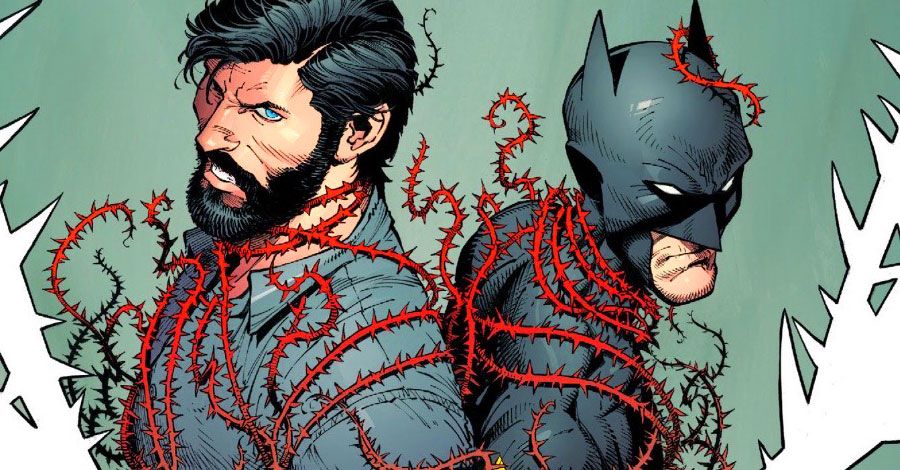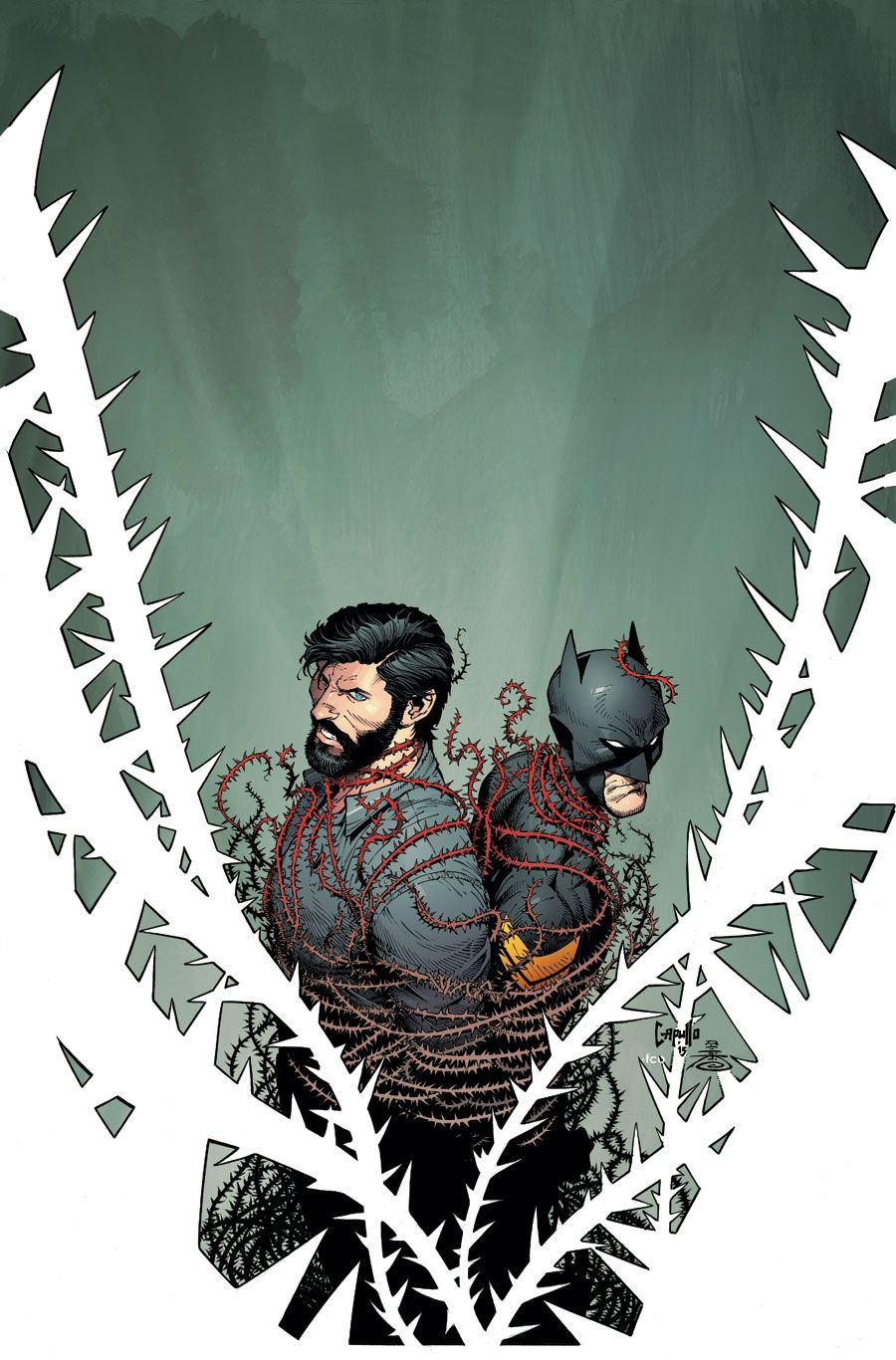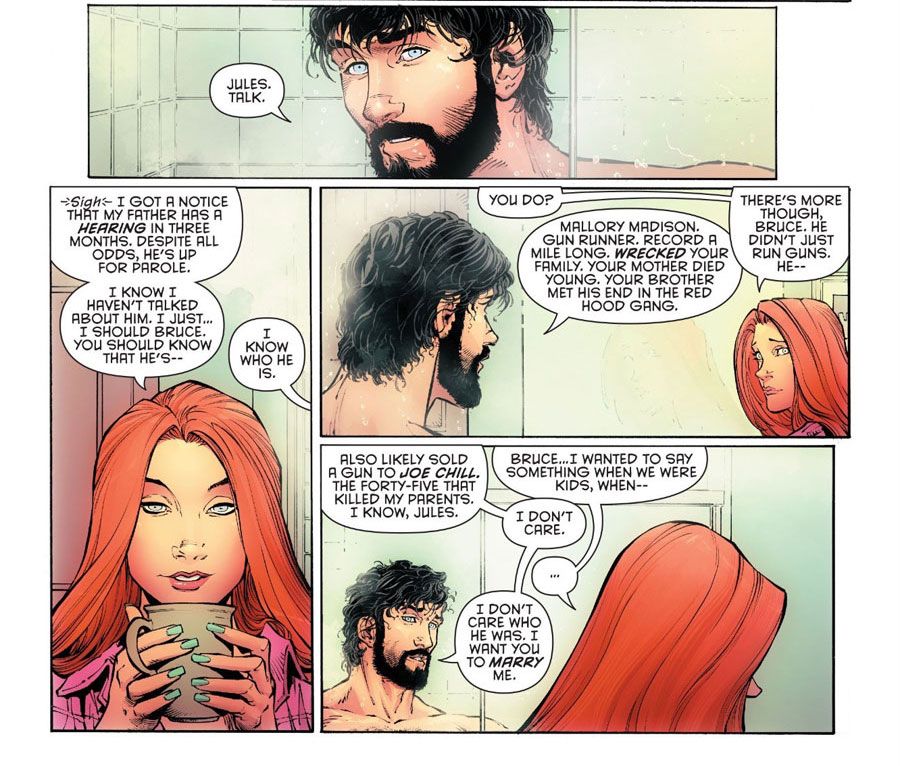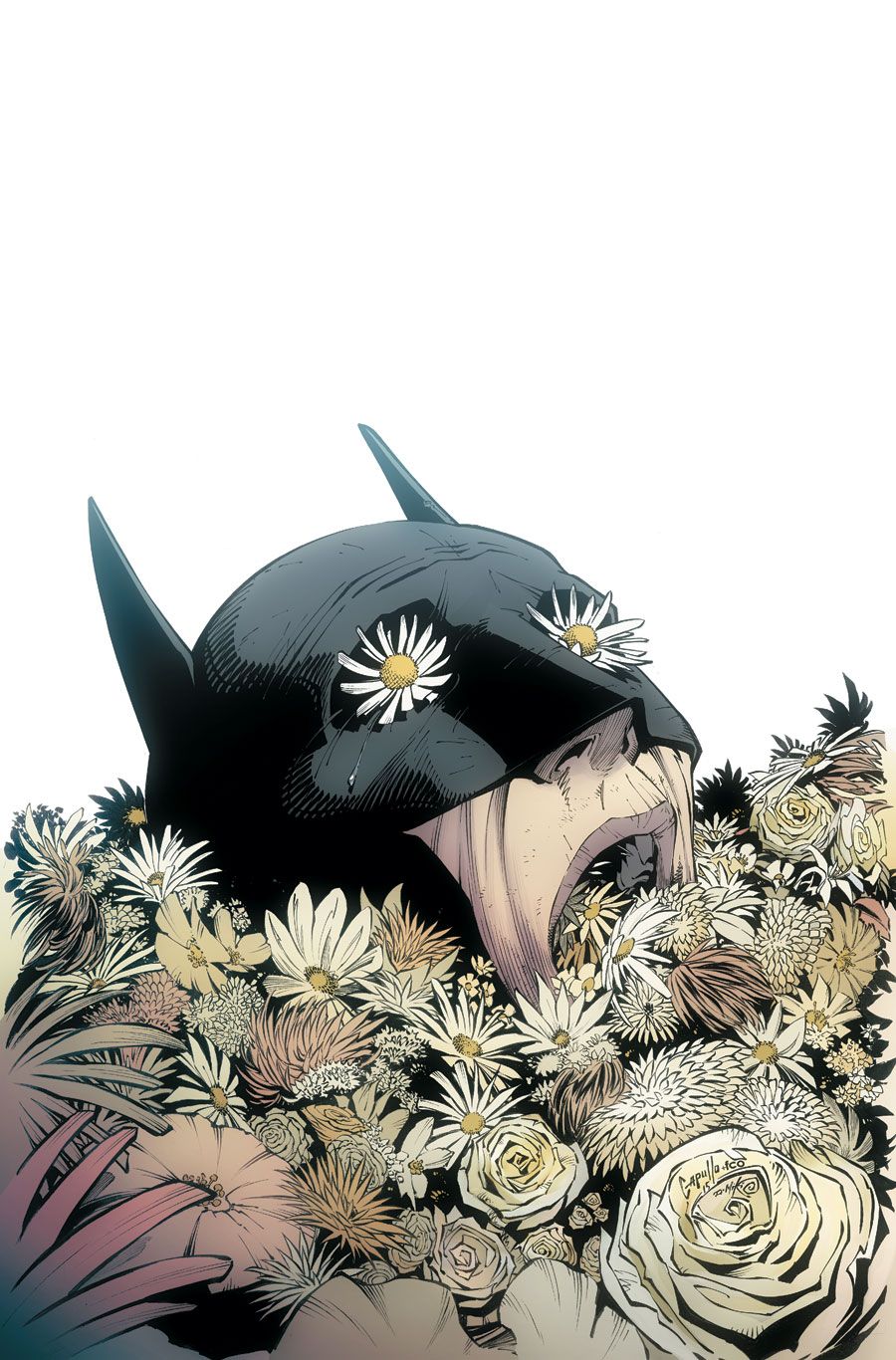SPOILER WARNING: This article contains major spoilers for "Batman" #46, available now.
Like a relentless, ruthless garden weed, Mister Bloom won't stop spreading until he's rooted himself in every crack and corner in Gotham City. And with an amnesiac Bruce Wayne living out a pseudo-fantasy of domestic bliss with Julie Madison, the only one to stop the new villain is Jim Gordon and his trusty sidekick, a superpowered, self-aware Bat-suit.
In "Batman" #46, by the superstar creative team of Scott Snyder and Greg Capullo, Jim and his Bat-bot face off against Batman's newest rogue, not once but twice. And in the climactic sequence, the balance of power shifts swiftly when the one thing that Jim's places his total faith in fails him.
RELATED: Did Bruce Wayne Just [Spoiler] in "Batman" #46?
Snyder told CBR News that when he's telling stories that appear midway through an arc, it's important for him to have a theme so each issue comprises a complete story unto itself. For "Batman" #46, it's all about seeing the things you hold true fall apart in front of you.
RELATED: Did Bruce Wayne Just [Spoiler] in "Batman" #46?
Capullo shared his thoughts on the ever-increasing creepiness of Mister Bloom, explaining how he went about creating even more tension between Jim and his target, and the dynamic creative duo also discussed Bruce's upcoming nuptials.
Wait, what?!?
CBR News: Lots of Batman v. Bloom to discuss here but hold the Bat-phone, did Bruce Wayne just propose to Julie Madison?
Scott Snyder: Yeah, yeah, he did! [Laughs] And he got lucky for the first time in our entire run. We've never given Bruce any romance in five years. It's been a long dry spell.
Greg Capullo: And a lot of callouses. [Laughs]
Snyder: The closest he came to any kind of romance was his relationship with The Joker. This is a big deal.
But, of course, because it's Batman -- and superhero comics in general -- this won't end well, will it?
Snyder: No. [Laughs]
One of the things that we're tried to be really conscious of [during our run] is how many stories have used the trope of the death of a romantic interest becoming the motivator for the hero or the romantic interest turns out to be the big, bad guy. That's not what we're going for, here. Even though we all know it can't end well, we're really trying to make it work as a story. We really wanted this story to be about, who would Bruce Wayne be if he was free of being the Batman? And Julie, to me, is that plot point. She is the closing of that circle. "My parent was basically the bullet and your parents were the victims." This story closes that loop. "Bruce, you are now alive again."
One of the points of the story is whether or not Batman is real. Did Bruce Wayne survive Crime Alley, or didn't he -- in a symbolic way? He went down the alley with his parents. and there was a third bullet that may not be real, but it hit him in another way. Batman is essentially a phantom that comes from the land of the dead. This story shows Bruce Wayne alive. The city is telling him that he has been resurrected. There is something really powerful about that.
Bloom reveals in this issue, "I was one of you, once. A bleeding heart." As we learn more about Gotham's past and Blossom Row, are we to feel for Bloom because he is more of a product of Gotham rather than your everyday supervillain?
Snyder: Yeah, very much so. To me, he's the inverse of Joker. I was toying with actually saying just that at some point, but I thought it was just too self-conscious. Joker is a character, for me, that -- no origin is good enough for him, because he is so larger-than-life scary. Any origin for him feels lacking. The scary thing about Bloom, to me, is that any origin is good enough for him. [Laughs] He can be any one of us, disillusioned by our failures and frustrations in a place like Gotham, or New York, or Baltimore, or Chicago. It's that feeling of, "This isn't going to work. It's all lies. None of it's true. The promises made don't exist. I will become with this thing." And he's always waiting there for you to make this decision.
In the next issue, or two issues from now, so, spoiler, we'll actually reveal that he's somebody who was heading for the potter's field. He realized that he was going to be buried, unknown, in Gotham's potter's field. And that sense of devoting yourself to a place, and believing in it, and then realizing that you're going to die anonymously and become nothing, dirt -- it's the essence of him. "I am going to come back from the dirt as this weed, as this thing that is going to kill your whole fucking garden. You know what, you want Gotham to look like this beautiful, little garden with flowers and everything? Well, it's a still a war. Plants fight for sunlight." If you took a microscope and looked up close at any manicured garden, it's actually a battle all over the place, and that's what he's saying. "It's diverse, it's robust, but deep down, everybody's fighting each other. Everyone is vying for sunlight, looking pretty for the camera. Why don't we admit what we are and just grow wild?"
Capullo: You should be a writer. [Laughs]
But seriously, he's such a fun character to draw, too. Especially when you consider my roots, drawing "Spawn" for Image. I love it. When the issue opens and Geri Powers snatches the dollar from Bloom's finger before anything else can happen, the whole scene just comes to life for me. It's like watching a monster movie. Seeing Bloom get more and more vicious, and more and more creepy is great. The flower kind of peels off his face. He's super scary.
Jim Gordon nearly gets his man in the opening sequence, but Bloom manages to escape despite the use of some awesome tech and the assistance of Julia Pennyworth. We've talked about this before, but Jim still has doubts about donning the cape and cowl and uses self-deprecation and humor to mask his worries. That doesn't deter Jim here, though, because he still wants one more crack at Bloom, mano a mano.
Snyder: Yeah, this is his big test. For me, the thing about Jim that is so great is that he stepped up and said, "I can be this guy that bridges this incredible chasm of faith, between the service system that people put in place to protect themselves in a place like Gotham, and the people themselves." What Bloom is holding over him is that the police and government and everything else Jim's devoted his life to don't need symbols, and they don't need superheroes. They need people, who are culpable and generous and passionate. The tragedy of Jim in this story is that he has forgotten that, and overstepped it in a way I think is heroic and noble, but ultimately doomed. That's what I love about writing Jim. He's complicated. He's living a fantasy.
Capullo: I don't know if you write it this way, but to me, his sense of humor could be considered wildly inappropriate, but he uses it to comfort himself. He uses it to distract himself.
Snyder: That's exactly what I'm doing. I actually have a line in "Batman" #48 where he says to himself, because he's in really, really deep water, "Keep joking all the way to your grave."
The thing about Jim is that he knows who Batman is. He knows that it's Bruce, but he denies it. He won't let himself know that. His whole point to being a cop in Gotham is, in the macro, larger way, hopeless, because Gotham is corrupt in so many ways. But the differences that he makes as an individual matter and carry forward and inspire people. And that's the lesson of Batman himself. There will always be another villain. It will never be finished. Eventually, he'll fall, but it's that struggle that drives him. Jim's weapon is humor. He deflects all of this by joking. There is a total parallelism. He knows the darkness, and he knows the tragedy of himself, but he'll make you laugh.
Explaining foreshadowing to my kids, I told them about Chekhov's gun principle, that if you ever have a rifle hanging on a wall in the first scene of a movie, or play, or the first chapter of a book, it has to be fired. But I admit, I did not see what you had coming for squad-bot. Treated as a sidekick in the opening of the issue, squad-bot -- now apparently powered by Bloom -- turns on Jim in the final scene. I loved the sequence, and the visuals are killer.
Capullo: The scene works because of the surprise. What made it so much fun to draw was putting Bloom way up high and just concentrating on him, almost ignoring Gordon, because you don't know if he's in the power suit. Treating Bloom in that way was the best part and really added to the punchline.
Snyder: That's what I love about Greg. For me, that's the point of the issue. When you are doing middle issues of a big arc, you have to have the connective tissue, but you have to find ways of making them stand alone, too. The last one was all about stability and trying to create a safe space, whether it's creating a playground out of stuff that's scary, or Geri saying, "This is going to be our island," in terms of using these 'bots and the collider as protection. This one is all about the things that you put your faith in falling apart.
It's literally like Duke Thomas going into Penguin's lair -- with his faith and his own abilities and knowing the city and knowing the people -- and it all falling apart when he gets attacked. Bruce feels completely safe and suddenly realizes that he's not that safe, because the seed he had is gone. "Maybe I should have been more involved?"
Here, the thing that Jim relies on most -- his suit -- is turning on him. And Bloom is saying that will always happen. The things that you believe in, the things that you have to lose, will always fail.
And again, Greg always knows where I am going, before I even go there. I love that last scene because the 'bot has a personality, and that comes into play in a big way next issue. Gordon gives it a kiss. [Laughs]
"Batman" #46, by Scott Snyder and Greg Capullo, is available now.





